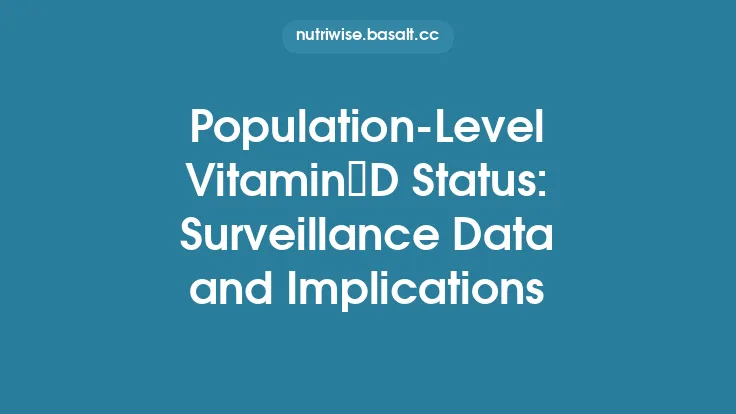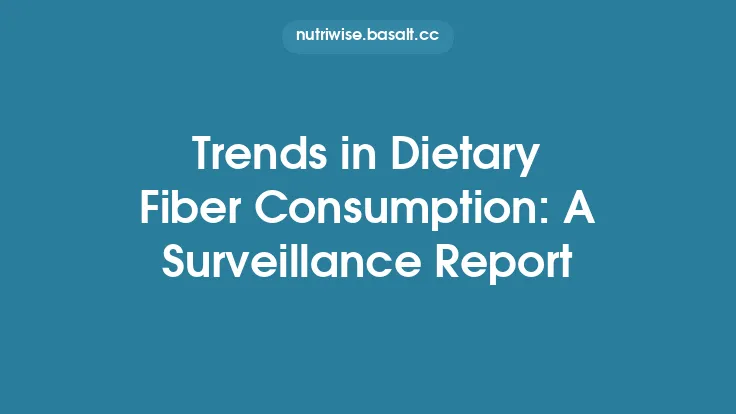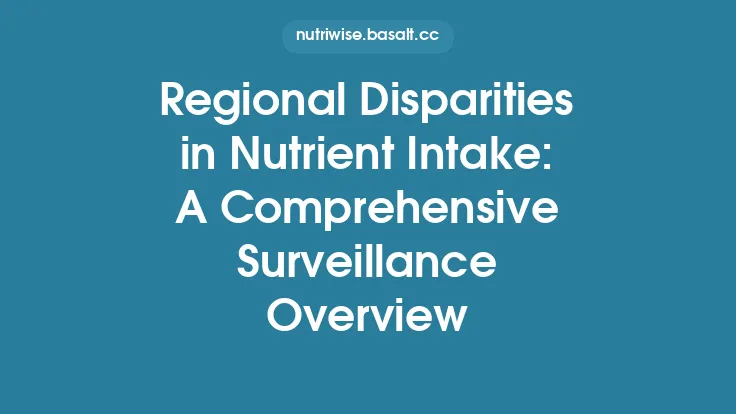Obesity has become one of the most pressing public‑health challenges of the 21st century, affecting individuals across the lifespan and imposing substantial economic and societal costs. Accurate, timely, and comparable estimates of obesity prevalence are essential for guiding policy, allocating resources, and evaluating the impact of interventions. Population‑level surveillance—systematic, ongoing collection, analysis, and dissemination of health data—offers the most reliable avenue for tracking obesity trends over time and across geographic regions. This article provides a comprehensive overview of the methods employed in obesity surveillance, recent methodological advances, and practical considerations for interpreting and applying surveillance findings.
Foundations of Obesity Surveillance
Defining Obesity in Population Settings
The most widely accepted metric for classifying obesity in adults is the body mass index (BMI), calculated as weight in kilograms divided by height in meters squared (kg/m²). The World Health Organization (WHO) defines obesity as a BMI ≥ 30 kg/m², with further subclassifications (class I: 30–34.9, class II: 35–39.9, class III: ≥ 40). For children and adolescents, age‑ and sex‑specific BMI percentiles or z‑scores relative to reference growth charts (e.g., WHO Growth Standards, CDC Growth Charts) are used, with the 95th percentile commonly denoting obesity.
While BMI remains the cornerstone of surveillance due to its simplicity and comparability, complementary anthropometric measures—waist circumference (WC), waist‑to‑hip ratio (WHR), and body fat percentage (via bioelectrical impedance or dual‑energy X‑ray absorptiometry)—provide valuable insight into fat distribution and metabolic risk. Surveillance systems increasingly incorporate these measures, especially when the goal is to capture central adiposity, which is more strongly linked to cardiometabolic outcomes.
Rationale for Ongoing Surveillance
- Trend Detection: Identifying upward or downward shifts in prevalence informs the urgency and scale of public‑health responses.
- Geographic Targeting: Mapping obesity hotspots enables region‑specific interventions.
- Equity Assessment: Disaggregating data by socioeconomic status, ethnicity, and other demographic variables highlights disparities.
- Policy Evaluation: Pre‑ and post‑implementation data assess the effectiveness of policies such as sugary‑drink taxes or nutrition labeling mandates.
- Research Support: High‑quality surveillance data serve as a foundation for epidemiologic studies exploring determinants and consequences of obesity.
Core Data Sources for Obesity Surveillance
| Data Source | Strengths | Limitations |
|---|---|---|
| National Health Interview Survey (NHIS) / Similar Household Surveys | Large, nationally representative samples; rich sociodemographic data; longitudinal panels in some countries. | Relies on self‑reported height/weight, which can introduce systematic bias (under‑reporting of weight, over‑reporting of height). |
| Physical Examination Surveys (e.g., NHANES, Health Survey for England) | Direct measurement of height, weight, WC, and other biomarkers; high data quality. | More costly; smaller sample sizes; less frequent data collection cycles. |
| Electronic Health Records (EHRs) & Clinical Registries | Near‑real‑time data; large patient populations; potential for repeated measures. | Variable data completeness; selection bias toward health‑seeking individuals; standardization challenges across systems. |
| School‑Based Health Assessments | Captures child and adolescent populations; can integrate fitness testing. | May miss out‑of‑school youth; data quality depends on training of personnel. |
| Community‑Based Cohort Studies | Detailed exposure data; ability to link lifestyle factors with obesity outcomes. | Not always nationally representative; limited to specific regions or subpopulations. |
| Wearable & Mobile Health (mHealth) Platforms | Continuous, objective data on activity and, in some devices, body composition. | Emerging technology; data privacy concerns; representativeness issues. |
A robust surveillance system often triangulates multiple sources, using statistical techniques to adjust for known biases and to harmonize definitions across datasets.
Methodological Considerations
Sampling Design
- Probability Sampling: Simple random, stratified, or multistage cluster sampling ensures each individual in the target population has a known, non‑zero chance of selection, facilitating unbiased prevalence estimates.
- Oversampling of High‑Risk Groups: Intentional oversampling of minorities, low‑income households, or specific age brackets improves precision for sub‑group analyses.
- Weighting Procedures: Post‑stratification weights correct for differential non‑response and align the sample with known population demographics (e.g., census data).
Measurement Protocols
- Standardized Anthropometry: Use of calibrated stadiometers and digital scales, with participants wearing light clothing and no shoes. Repeated measurements (at least two) are recommended, with a third measurement if the first two differ beyond a pre‑specified threshold (e.g., >0.5 kg for weight).
- Quality Assurance: Field staff undergo rigorous training, certification, and periodic re‑assessment. Inter‑observer reliability is monitored through duplicate measurements on a subsample.
- Self‑Report Adjustments: When self‑reported data are unavoidable, correction equations derived from validation studies (e.g., regression models predicting measured BMI from self‑reported values) are applied to mitigate bias.
Data Harmonization
- Unit Consistency: Convert all measurements to metric units (kg, cm) before analysis.
- Age‑Standardization: Apply direct standardization using a reference population (e.g., WHO World Standard Population) to enable comparisons across time and between countries with differing age structures.
- Definition Alignment: Ensure that obesity cut‑offs are consistent across datasets; for children, adopt a single growth reference (e.g., WHO) to avoid cross‑reference discrepancies.
Statistical Analyses
- Prevalence Estimation: Weighted proportions with 95 % confidence intervals (CIs) are calculated using survey‑specific procedures (e.g., `svy` commands in Stata or `survey` package in R).
- Trend Analysis: Joinpoint regression identifies points where the slope of prevalence change significantly shifts, providing annual percent change (APC) estimates.
- Geospatial Mapping: Bayesian hierarchical models incorporate spatial autocorrelation, producing smoothed prevalence maps that account for small‑area sample variability.
- Multilevel Modeling: Allows simultaneous assessment of individual‑level predictors (e.g., age, education) and contextual factors (e.g., neighborhood walkability, food environment).
Emerging Technologies and Data Innovations
Integration of Wearable Sensors
Modern wearables can estimate body composition through bioimpedance, providing an alternative to traditional anthropometry. Large‑scale pilot studies have demonstrated acceptable agreement (intraclass correlation coefficients > 0.80) with standard measurements, especially when devices are calibrated against reference methods. Incorporating wearable data into surveillance pipelines offers the potential for near‑real‑time monitoring of weight trajectories.
Use of Machine Learning for Data Imputation
Missing anthropometric data, a common issue in large surveys, can be addressed using machine learning algorithms (e.g., random forests, gradient boosting) that predict missing values based on a rich set of auxiliary variables (demographics, health behaviors, medical history). Validation against complete‑case analyses shows reduced bias and improved precision in prevalence estimates.
Linking Administrative Health Data
Administrative databases (e.g., insurance claims, hospital discharge records) often contain diagnostic codes for obesity (ICD‑10 E66). While these codes capture clinically recognized obesity, they underrepresent the true prevalence. However, linking such data with survey measurements enables validation studies and the development of correction factors for administrative estimates.
Digital Surveillance Dashboards
Interactive dashboards powered by open‑source platforms (e.g., R Shiny, Tableau Public) allow stakeholders to explore obesity prevalence by age, sex, region, and time. Real‑time updates, when coupled with automated data pipelines, enhance transparency and facilitate rapid policy response.
Quality Assurance and Validation
- Pilot Testing: Prior to full rollout, conduct a pilot to assess feasibility, measurement error, and respondent burden.
- External Validation: Compare prevalence estimates with independent data sources (e.g., national health registries) to assess concordance.
- Reliability Checks: Calculate intra‑class correlation coefficients for repeated anthropometric measurements within a subsample.
- Bias Audits: Periodically evaluate the impact of non‑response, especially among hard‑to‑reach groups, using follow‑up surveys or weighting adjustments.
- Documentation: Maintain a detailed methodological handbook, version‑controlled, to ensure reproducibility and facilitate future updates.
Interpreting Surveillance Findings
- Contextualizing Prevalence: Raw prevalence figures should be interpreted alongside measures of severity (e.g., proportion of class II/III obesity) and associated comorbidities (e.g., hypertension, type 2 diabetes).
- Temporal Dynamics: Short‑term fluctuations may reflect seasonal variations in physical activity or dietary patterns; however, sustained trends are more indicative of structural changes (e.g., urbanization, food system shifts).
- Geographic Disparities: Spatial analyses often reveal clusters of high obesity prevalence in areas with limited access to healthy foods or safe recreational spaces. These patterns underscore the need for place‑based interventions.
- Equity Lens: Disaggregated data frequently show higher obesity rates among lower socioeconomic groups, highlighting the intersection of poverty, food insecurity, and limited health‑promoting resources.
Policy Implications and Applications
- Targeted Interventions: Surveillance data guide the allocation of resources to high‑prevalence regions, enabling community‑level programs such as nutrition education, physical‑activity infrastructure, and weight‑management services.
- Regulatory Measures: Evidence of rising obesity prevalence can support the enactment of policies like front‑of‑package labeling, restrictions on marketing of energy‑dense foods to children, and fiscal measures (e.g., sugar‑sweetened beverage taxes).
- Healthcare Planning: Accurate prevalence estimates inform workforce planning for obesity‑related services, including bariatric surgery capacity and multidisciplinary weight‑management clinics.
- Monitoring Policy Impact: By establishing baseline prevalence and conducting periodic follow‑ups, surveillance systems provide the empirical basis for evaluating the effectiveness of policy interventions over time.
- International Comparisons: Harmonized methods enable cross‑country benchmarking, fostering global collaboration and the sharing of best practices.
Future Directions
- Standardization Across Nations: Continued efforts by WHO and other international bodies to adopt uniform measurement protocols and reporting standards will enhance comparability.
- Integration of Genomic Data: As biobanks expand, linking genetic risk scores with surveillance data may illuminate population‑level susceptibility patterns.
- Real‑Time Surveillance: Leveraging EHRs, mobile health apps, and cloud‑based analytics could shift obesity monitoring from periodic snapshots to continuous surveillance.
- Sustainability: Embedding obesity surveillance within existing health information systems reduces costs and ensures long‑term viability.
- Community Engagement: Involving community stakeholders in data collection and interpretation promotes trust, improves response rates, and ensures that findings translate into culturally appropriate actions.
Concluding Remarks
Population surveillance remains the cornerstone for understanding and combating the obesity epidemic. By employing rigorous sampling designs, standardized anthropometric measurements, and advanced analytical techniques, public‑health agencies can generate reliable, actionable data. Emerging technologies—wearables, machine learning, and integrated health‑information systems—promise to enhance the timeliness and granularity of obesity monitoring. Ultimately, high‑quality surveillance not only illuminates the scope of the problem but also empowers policymakers, clinicians, and communities to implement evidence‑based strategies that curb obesity and improve population health.





